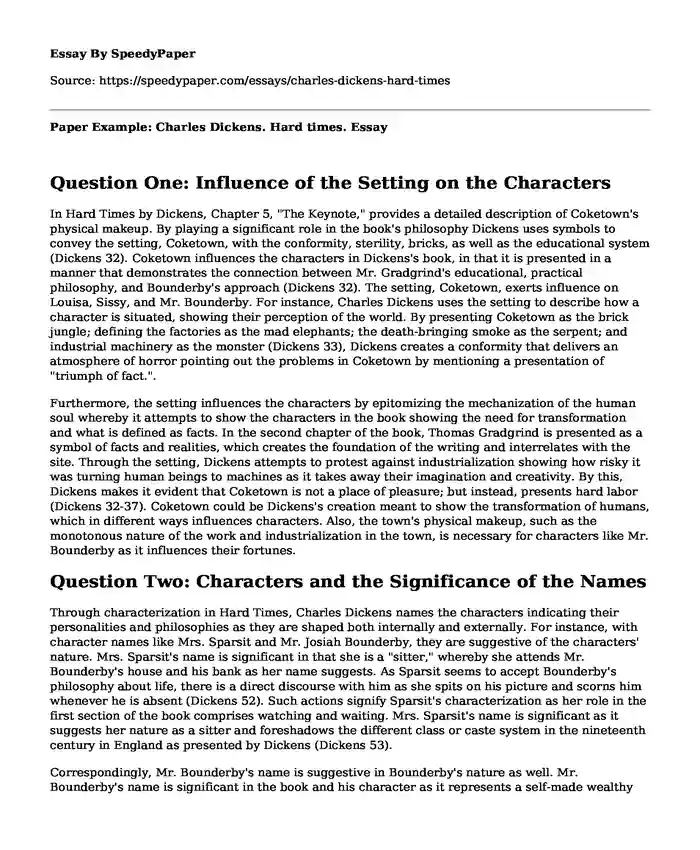
| Type of paper: | Book review |
| Categories: | Charles Dickens Character analysis World literature |
| Pages: | 3 |
| Wordcount: | 609 words |
Question One: Influence of the Setting on the Characters
In Hard Times by Dickens, Chapter 5, "The Keynote," provides a detailed description of Coketown's physical makeup. By playing a significant role in the book's philosophy Dickens uses symbols to convey the setting, Coketown, with the conformity, sterility, bricks, as well as the educational system (Dickens 32). Coketown influences the characters in Dickens's book, in that it is presented in a manner that demonstrates the connection between Mr. Gradgrind's educational, practical philosophy, and Bounderby's approach (Dickens 32). The setting, Coketown, exerts influence on Louisa, Sissy, and Mr. Bounderby. For instance, Charles Dickens uses the setting to describe how a character is situated, showing their perception of the world. By presenting Coketown as the brick jungle; defining the factories as the mad elephants; the death-bringing smoke as the serpent; and industrial machinery as the monster (Dickens 33), Dickens creates a conformity that delivers an atmosphere of horror pointing out the problems in Coketown by mentioning a presentation of "triumph of fact.".
Furthermore, the setting influences the characters by epitomizing the mechanization of the human soul whereby it attempts to show the characters in the book showing the need for transformation and what is defined as facts. In the second chapter of the book, Thomas Gradgrind is presented as a symbol of facts and realities, which creates the foundation of the writing and interrelates with the site. Through the setting, Dickens attempts to protest against industrialization showing how risky it was turning human beings to machines as it takes away their imagination and creativity. By this, Dickens makes it evident that Coketown is not a place of pleasure; but instead, presents hard labor (Dickens 32-37). Coketown could be Dickens's creation meant to show the transformation of humans, which in different ways influences characters. Also, the town's physical makeup, such as the monotonous nature of the work and industrialization in the town, is necessary for characters like Mr. Bounderby as it influences their fortunes.
Question Two: Characters and the Significance of the Names
Through characterization in Hard Times, Charles Dickens names the characters indicating their personalities and philosophies as they are shaped both internally and externally. For instance, with character names like Mrs. Sparsit and Mr. Josiah Bounderby, they are suggestive of the characters' nature. Mrs. Sparsit's name is significant in that she is a "sitter," whereby she attends Mr. Bounderby's house and his bank as her name suggests. As Sparsit seems to accept Bounderby's philosophy about life, there is a direct discourse with him as she spits on his picture and scorns him whenever he is absent (Dickens 52). Such actions signify Sparsit's characterization as her role in the first section of the book comprises watching and waiting. Mrs. Sparsit's name is significant as it suggests her nature as a sitter and foreshadows the different class or caste system in the nineteenth century in England as presented by Dickens (Dickens 53).
Correspondingly, Mr. Bounderby's name is suggestive in Bounderby's nature as well. Mr. Bounderby's name is significant in the book and his character as it represents a self-made wealthy middle-aged man. By fabricating his childhood story, Mr. Bounderby creates a legend of himself as an individual that rose from the gutter to the present. Through Mr. Bounderby's name, Dickens attempt to signify the interaction and relationship of Mr. Bounderby's with other characters in the book, such as the Grandgrinds, Louisa, Tom, Harthouse, as well as the setting of the book (Dickens 51-57). This is significant as it signifies the direct association of an individual's lifestyle and how their character would affect the association with other people.
Works Cited
Dickens, Charles. Hard times: A novel. No. 192. Harper & Brothers, 1854.
Cite this page
Paper Example: Charles Dickens. Hard times. . (2023, Mar 24). Retrieved from https://speedypaper.com/essays/charles-dickens-hard-times
Request Removal
If you are the original author of this essay and no longer wish to have it published on the SpeedyPaper website, please click below to request its removal:
- Free Leadership Essay Example
- Paper Example on Essay and Text Message Writing
- Essay Example on Nestle Company Research
- Essay Example: Anthony's Orchard Current Financial Health
- Same Sex Schools: Research Proposal Exampe
- Flexibility of the Indigenous - Case Study Paper Sample
- Company Case Spirit Airlines
Popular categories




